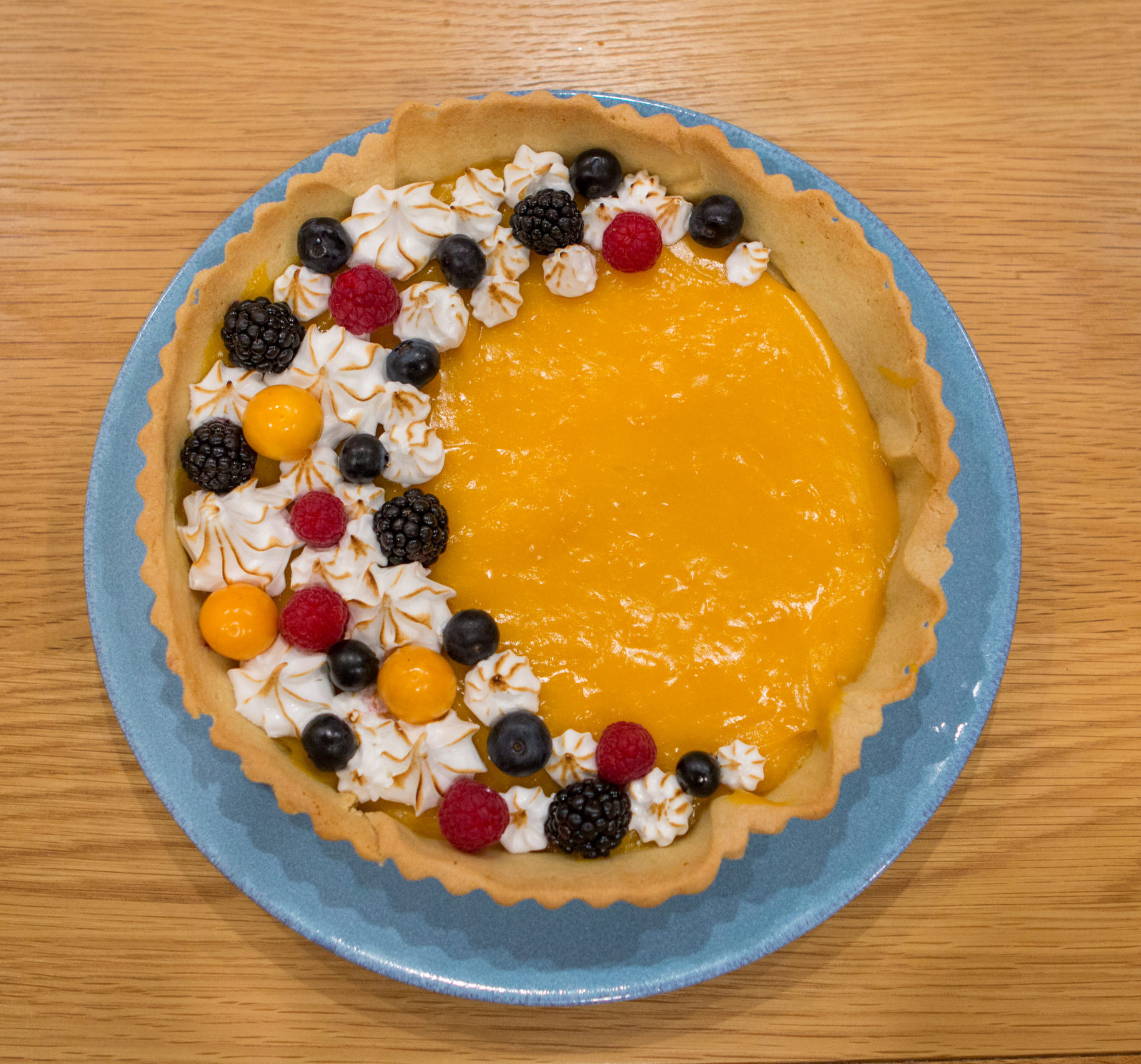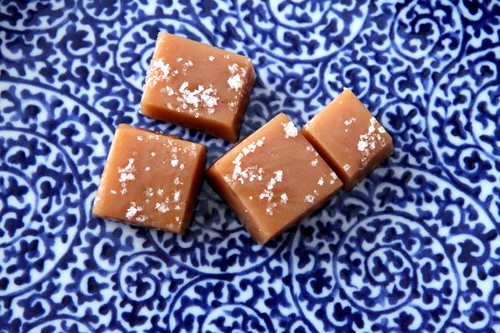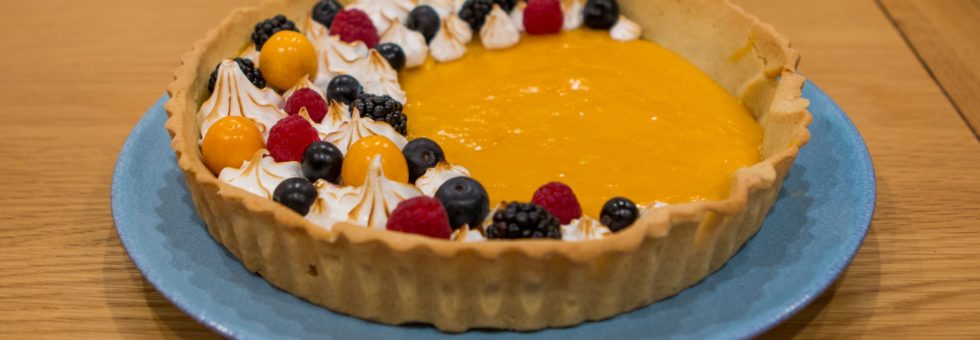I wanted to try an alternative to the famed French tarte au citron (lemon tart) and opted for a very appealing vibrant yellow passion fruit tart topped with meringue. The website for my source recipe is a little tricky to navigate, but helpfully they also posted a video showing how it is made. The sweet shortcrust pastry contains ground almonds and lime zest for something a little different, and is filled with a passion fruit curd. It is all topped off with neatly piped Italian meringue, carefully blow-torched for effect. I also added some fresh fruit for decoration.
Baking
The recipe uses a whopping 9 passion fruits for the curd. However, these did not produce the required amount of liquid stated in the recipe, as the pulp varied substantially between them. I topped mine up with some mango and passion fruit coulis I happened to have in the fridge.
Handling the pastry proved to be tricky. I tried working the pastry after refrigerating it for one hour as directed, but my hands quickly warmed it up, particularly due to the new springtime weather. I’d recommend leaving the pastry to chill for longer before using. You could even make it the day before you plan to use it, bearing in mind that it will take a fair few minutes for the pastry to become malleable again.
I came across a helpful video showing you how to carefully line a tart tin. You need to avoid letting the edges of the tin cut the dough, and instead lift the pastry into the middle and press into the corners. The best way to trim off the excess is to run a rolling pin over the top, as shown in the video. If you’ve ever wondered how much you’re supposed to prick the pastry base then this gives a good indication.
The passion fruit curd was straight-forward to make and a delicious flavour, one I would certainly make again.
Translation
Say it with flours
This recipe took me into the dreaded world of French flour types, specifying “T55 flour”. In France they often use a numbering system, whereby the figure refers to the amount of mineral left over after burning the flour, i.e. T55 flour has 0.55% ash left over, whereas T45 (also known as 00 or pasta flour) as 0.45%, and is whiter. I had never previously come across these flour references in a recipe before and was sent on a wild goose chase when investigating.
The information out there can confusing and conflicting. One website listed the different types of flour by country, referring to it as Strong flour in the UK. According to another bakery website, T55 flour is usually used for making bread and pastries and the protein content referenced is 11-12%, which aligns with normal UK supermarket strong white bread flour. However, strong flour would not be used for a short crust pastry as you need to keep it short and ensure you do not develop the gluten.
Another website listed a lower protein content for T55 flour: 9.5%, which makes more sense. I was relieved to find this website which clearly explains that T55 equates to all-purpose, i.e. plain flour. I was pleased to come to this conclusion as a short crust pastry would usually only be made using plain flour in the UK. It was a murky world to navigate, and it would be interesting to know whether French wheat gives different outcomes to the UK equivalent flour types. An exercise for non-quarantine times perhaps…
Tipping point
To pipe the meringue decoration the recipe recommends using two different types of piping tips or douilles: one is a “douille cannelée” and the other a “douille petits-fours”. These both appear to be variations of a star shape, with douille cannelée often translated as “star tip/nozzle”, “fluted tip” or even “French tip”. I decided to go with star nozzle, as it more accurately explained the shape. A “douille petit-fours” appears to be the same but with more teeth, so I went with “petit four star tip”, which I have seen in some baking descriptions.
Pastry
Once the tin has been lined with the pastry, the recipe instructs you to leave to refrigerate for at least one hour before baking and says that the longer you keep it refrigerated the more it will “restera bien en place à la cuisson”, literal translation: remain in place when cooking. This refers to the fact that pastry often shrinks down away from the sides of the tin, leaving a shallow pastry base. This has happened to me all too often and I used to leave an overhang, which I’d trim off later after baking. However, this left a somewhat messy result, so I was incredibly grateful for this little tip. I chose to translate this as “the longer you keep it refrigerated the less likely it is to shrink when cooking”. I left mine in the fridge for 2 hours before baking and it didn’t shrink at all.

Fleur de sel
A new ingredient I came across was fleur de sel (literal translation: flower of salt), which is usually left in French to distinguish from other types of salt. It is a type of delicate finishing salt known for its bright, white crystals. It evaporates to form a crust on the surface of seawater and is harvested through a careful raking process due to its fragile nature.
It has a saltier and more complex flavour than table salt as it also contains calcium and magnesium chloride. Due to its higher moisture content, it is unsuitable for salt mills and is not usually used in the cooking process, but rather as a garnish to boost the flavour of a range of ingredients from meat, eggs and vegetables to chocolate and caramel.
This website helpfully sets out the difference between coarse sea salt and fleur de sel. For more information on fleur de sel and its suggested uses see here.

Other vocabulary
It was interesting to learn that the flat beater used in a stand mixer is referred to as a ‘feuille’, meaning leaf, owing to its leaf-like shape.
The passion fruit curd had to be left to “figer”, literal translation: freeze, clot, congeal, solidify, here: set. A new word to me, which I’m sure will crop up again.
Overall
This tart was a real pleasure to both make and devour. There was a good balance of textures: a crunchy pastry base, a gooey curd and a light meringue topping. It was also enjoyable to decorate with different piping nozzles and fruit. My only criticism is that the curd looked a little lacking in my deep pastry case and I think it would work better with a shallower tin or as individual tartlets topped up higher.
Next week I’ll be making a favourite Spanish pastry of mine with a fruity twist…



